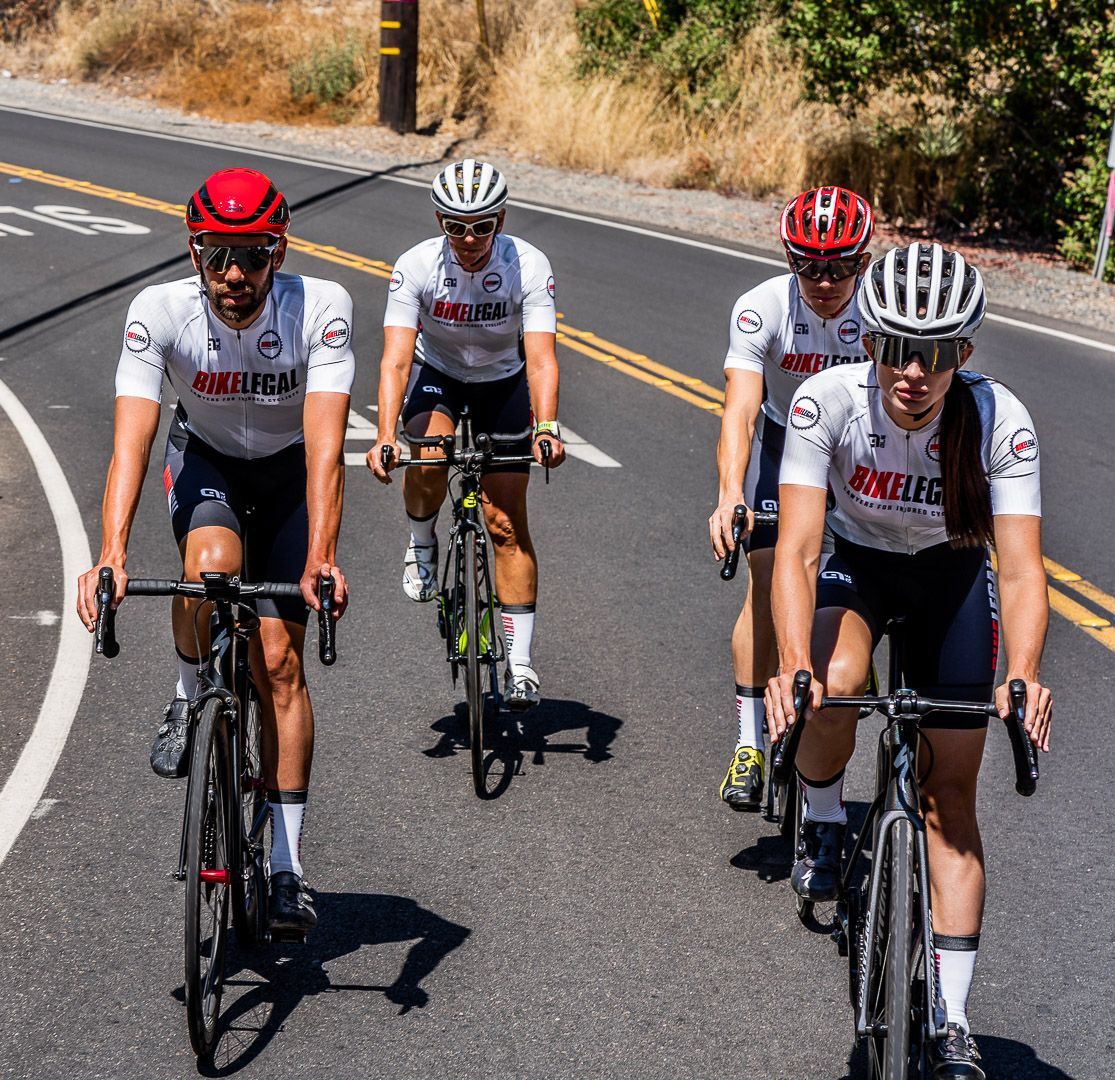Most Common Cycling Disciplines & Races Explained (2024)
Follow us on
social media!

Cycling encompasses a wide range of disciplines, each with its own techniques, equipment, and competitive formats. Whether you're looking to explore a new type of cycling, understand the differences between road, mountain, and gravel biking, or learn about racing categories, this guide provides a clear overview.
Covering everything from pavement, dirt, gravel, and the wooden boards of a velodrome, you'll gain insight into the most common cycling disciplines and the challenges, skills, and events associated with each.
Key disciplines we will discuss include:
- Road Cycling: The classic, perfect for speed and endurance.
- Mountain Biking: Get ready for rough terrain and adrenaline.
- Gravel Biking: The best of both worlds, mixing roads and trails.
- Bikepacking: Turn your ride into a multi-day adventure.
- BMX: Defy gravity with jumps, tricks, and races.
- Track Cycling: Lightning-fast action in the velodrome.
- Cyclocross: A wild mix of cycling, dismounting, and obstacles.
The Most Common Cycling Disciplines
When most people think of cycling, they often picture a road bike. While road cycling is one of the most popular disciplines, cycling offers many other options beyond paved roads. This section covers the most common cycling disciplines, each offering different experiences and challenges.
1. Road Cycling

Road cycling focuses on riding on paved surfaces, emphasizing speed, endurance, and efficiency. Riders typically use lightweight bikes with thin tires designed for long-distance or competitive racing. It is one of the most popular forms of cycling, ranging from casual rides to professional races like the Tour de France.
Road cycling is accessible to beginners but also offers challenging routes for experienced riders.
- History: Road cycling has a rich past, dating back to the late 1800s and the first organized races. Iconic events like the Tour de France have made it legendary.
- Equipment: Road bikes are all about speed and efficiency. Think lightweight frames, thin tires, and drop handlebars.
- Terrain: Paved roads are your playground. Hills, flats, and winding descents – variety is part of the fun.
- Ability Level: Road cycling welcomes everyone. From beginners cruising local streets to seasoned pros tackling mountain climbs, there's a challenge for all.
- Skills required: Pedaling technique, shifting gears, basic bike handling, and learning group riding etiquette if you join a club.
- Why people like it:
- The thrill of speed and testing your endurance
- The feeling of freedom as you explore new routes
- A strong sense of community, especially within clubs
- Challenges:
- Riding on the road with traffic can be dangerous.
- Learning how to handle your bike in groups takes practice.
- Proper bike maintenance is essential.
- Fitness and training required: Regular rides will build your cardiovascular fitness and leg strength. Cross-training is great for overall conditioning.
- Social aspect: Road cycling is a fantastic way to connect with other riders. Join a local club or find online communities to share the love of the road.
- Safety and dangers: Always wear a helmet. Drivers and road conditions can be hazards, so stay alert and follow traffic laws.
2. Mountain Biking

Mountain biking involves riding on off-road terrain, such as trails, hills, and rugged landscapes. Bikes are equipped with sturdy frames, wide tires, and suspension to handle rough surfaces and obstacles.
This discipline requires technical skills, including bike handling, balance, and navigating challenging terrain. Mountain biking ranges from leisurely trail rides to competitive formats like downhill and cross-country racing, offering both adventure and physical challenge.
- Equipment: Mountain bikes are beasts built for the rough stuff – think sturdy frames, chunky tires, and suspension to soak up bumps.
- Terrain: Think dirt, rocks, roots, and everything in between. Mountain bike trails range from mellow, flowy paths to gnarly, technical descents.
- Ability Level: Whether you're a beginner or a seasoned shredder, there's a mountain bike trail out there for you. Start with smoother trails and build your skills gradually.
- Skills required:
- Balance and maneuvering over obstacles
- Braking effectively and cornering on loose terrain
- Basic bike repair for flats, etc.
- Why people like it:
- Unmatched thrill and adrenaline
- Exploring stunning nature off the beaten track
- The satisfaction of improving technical skills
- Challenges:
- Can be physically demanding and mentally challenging
- Finding good trails can take some research
- Fitness and training required: Expect to work up a sweat. Mountain biking builds core strength, leg power, and endurance.
- Social aspect: Hit the trails with a buddy or join a mountain biking group for a fun and supportive experience.
- Safety and dangers: Helmets are a MUST on mountain bikes. Trails can be hazardous, so know your limits and choose trails that suit your skill level.
3. Gravel Biking
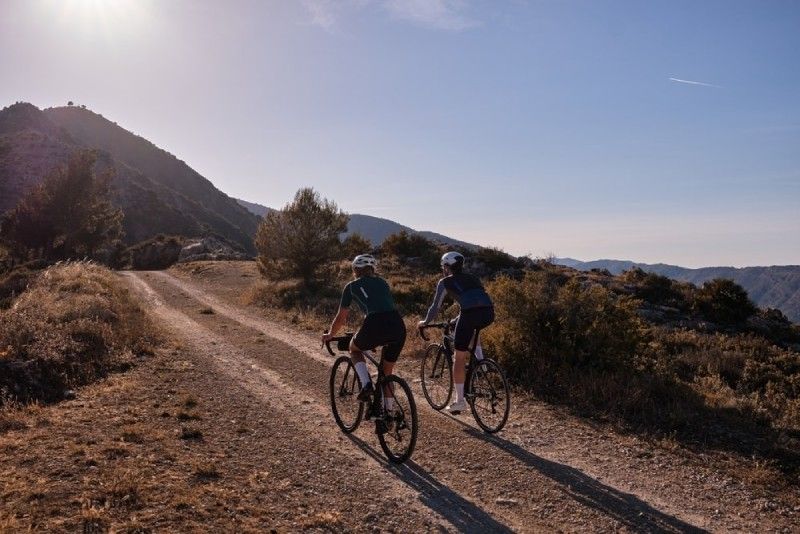
Gravel cycling combines elements of road and off-road riding, typically taking place on unpaved roads, gravel paths, and mixed terrain. Gravel bikes are designed for versatility, featuring wider tires and durable frames with drop handlebars. Gravel cycling is accessible to a wide range of skill levels and has grown in popularity due to its mix of challenge, freedom, and escape from traffic.
- Equipment: Gravel bikes look like beefier versions of road bikes, with wider tires, slightly different geometry, and often disc brakes for confident stopping power.
- Terrain: Think dirt roads, gravel paths, forest trails, and even the occasional paved section. Gravel rides are all about exploration and variety.
- Ability Level: Accessible to all. If you can ride a road bike, you can try gravel cycling. It's a great way to branch out for experienced road riders or an entry point for those who find mountain biking intimidating.
- Skills required: Similar to road riding with a bit more emphasis on bike handling and comfort on looser surfaces.
- Why people like it:
- Versatility to ride varied terrain
- Escape the traffic and discover new routes
- The fun of exploration and adventure
- Challenges:
- Gravel bikes can feel slower than pure road bikes
- Navigation can be trickier – be prepared with maps or GPS.
- Flat tire repair skills are vital as you're more likely to be further from help.
- Fitness and training required: Builds the same fitness as road cycling, but with added core strength to handle varied conditions.
- Social aspect: Gravel biking is booming in popularity, making it easy to find groups and events focused on exploring and socializing.
- Safety and dangers: Similar to road cycling, be mindful of occasional traffic and wear a helmet. Gravel roads can have hidden hazards, so ride control is key.
4. Bikepacking or Bike Touring
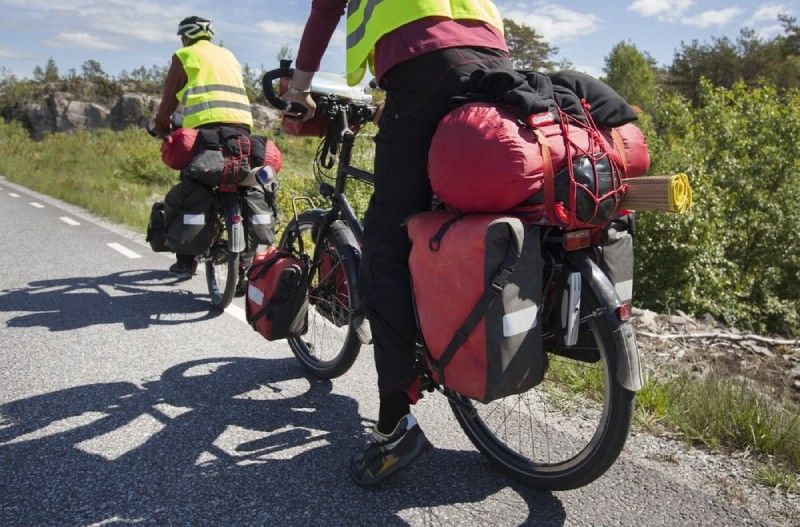
Turn your bike into your vehicle for multi-day adventures. Bikepacking is all about self-sufficiency, long-distance exploration, and the freedom of traveling under your own power.
- History: Bike touring has been around for ages, but modern bike-packing evolved as bike technology allowed for lighter, more adaptable gear setups.
- Equipment: The focus is on carrying what you need. You'll need bags specifically designed for bikepacking that attach to your frame, handlebars, and seat post.
- Terrain: The world is your oyster. Mix up paved roads, gravel paths, mild trails – wherever your sense of adventure leads you.
- Ability Level: Better suited to those with some cycling experience. Bikepacking requires endurance and a good handle on bike basics.
- Skills required:
- Bike maintenance and repair in remote settings
- Navigation and route planning
- Packing efficiently and minimalistically
- Why people like it:
- Deep connection with nature and a sense of accomplishment
- The freedom to travel at your own pace and explore off the tourist track
- Unplugging from everyday life
- Challenges:
- Carrying gear can make cycling more strenuous
- Weather changes can seriously impact your trip
- Requires more planning and preparation than a single-day ride
- Fitness and training required: Focus on building endurance for long days in the saddle. Strength training helps manage the extra weight of your gear.
- Social aspect: Can be a solo adventure or enjoyed with like-minded folks. Online communities offer support and camaraderie.
- Safety and dangers: Meticulous planning is key – know your route, have backup plans, and be prepared for anything the wilderness might throw your way.
5. BMX Cycling
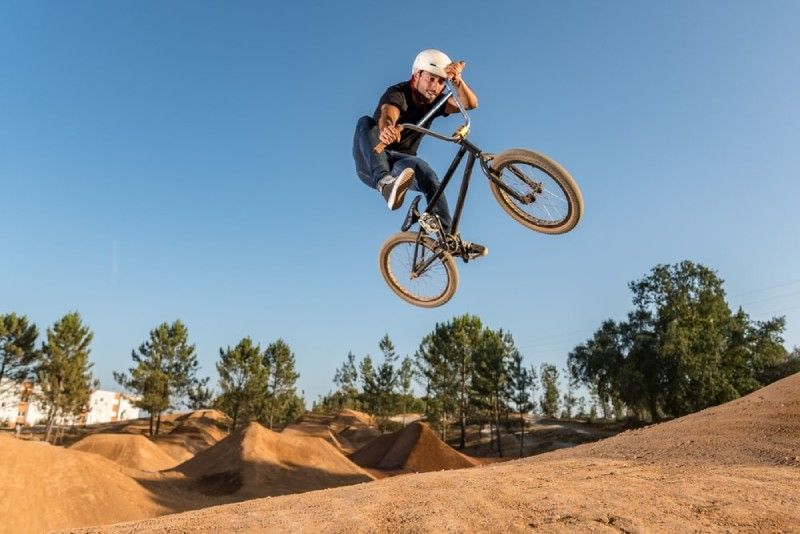
BMX is where adrenaline meets creativity. Think tight race tracks, big jumps, and gravity-defying tricks.
- History: BMX originated in Southern California in the late 1960s and early 1970s. Kids began modifying their 20-inch Schwinn Stingray bicycles to mimic motocross racing, unknowingly creating a new sport.
- Equipment: BMX bikes are small, sturdy, and built for agility. They typically have 20-inch wheels and a single gear.
- Terrain: Bicycle motocross tracks are packed with dirt jumps, berms, and technical features. You'll also find BMX riders at skateparks perfecting their skills.
- Ability level: Great for all ages. It's a fantastic place for kids to learn bike basics, and the pro scene includes athletes pulling off insane maneuvers.
- Skills required:
- Balance, coordination, and the ability to pump the track for speed
- Jumping and mastering aerial tricks (for advanced riders)
- Mental toughness for overcoming fear and learning through crashes
- Why people like it:
- Huge adrenaline rush and self-expression through tricks
- A fun and supportive community across skill levels
- Great way to introduce young kids to bicycle racing
- Builds confidence and resilience
- Challenges:
- Finding a good BMX track may require some searching
- Fitness and training required: Expect short, intense bursts of power while racing or practicing tricks. It's a full-body workout.
- Social aspect: BMX is all about community and hanging out at the track. Riders of all levels help and encourage each other.
- Safety and dangers: Always wear a helmet and protective gear. Know your limits and progress gradually when learning new skills.
6. Track Cycling
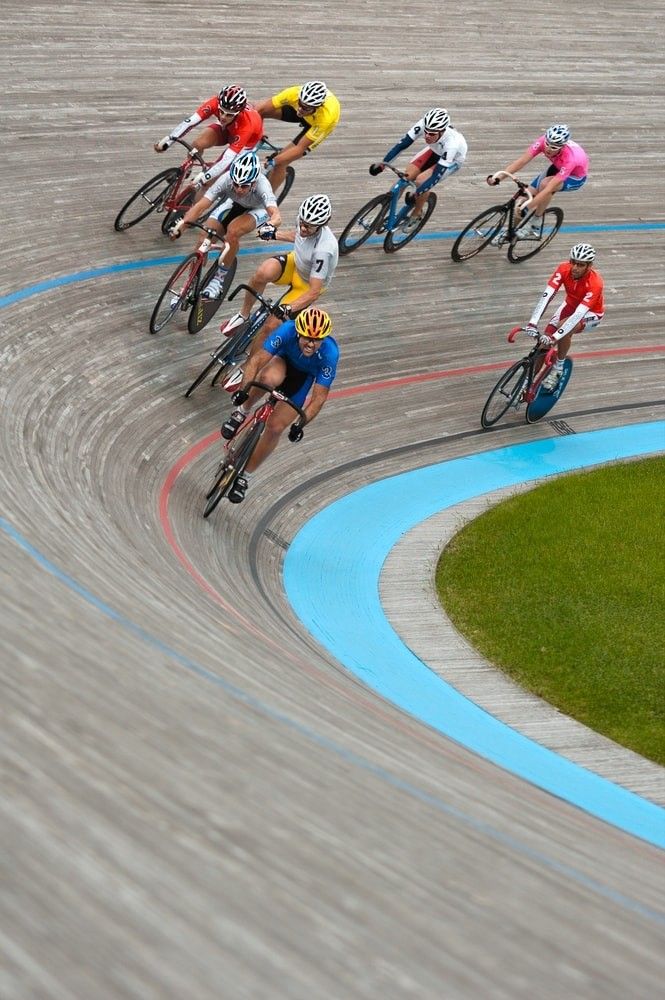
Pure speed, precision, and nail-biting competition happen on the velodrome. Track cycling features various race formats on a banked, oval track.
- History: Track cycling is one of the oldest cycling disciplines, with roots dating back to the late 1800s and inclusion in the first modern Olympic Games in 1896.
- Equipment: Track bikes are minimalist machines. They have a single fixed gear (no brakes), aero frames, and specialized handlebars for each discipline.
- Terrain: Velodromes are made of wood or concrete and typically 250 meters in length. They can be indoor or outdoor, with Olympic-standard tracks being much steeper and faster.
- Ability Level: Best for those with cycling experience. Track cycling requires specific skills and often certification before you can ride on the velodrome.
- Skills required:
- Mastering riding a fixed gear with no brakes with other people
- Training classes and certification to ride on the velodrome
- Ability to maintain constant speed
- High-speed cornering on a banked track
- Tactical race strategy and sprinting power
- Why people like it:
- Exhilaration of pure speed, adrenaline rush, and tactical racing
- Structured training environment to improve cycling skills
- Strong sense of community within the track scene
- Challenges:
- Getting access to a velodrome and necessary training
- High speeds without brakes can increase the risk of crashes
- Can be a very niche and specialized discipline
- Fitness and training required: Expect short, explosive efforts. Track cycling builds strong leg power and overall athleticism. Coached sessions on the track are highly recommended.
- Social aspect: Velodromes foster a tight-knit community of racers and enthusiasts.
- Safety and dangers: Crashes in track cycling events can be serious due to the high speeds and lack of brakes. Training sessions are key.
7. Cyclocross

Get ready for a wild mix of cycling, running, and mud. Cyclocross courses are short and technical, featuring obstacles that force you to hop off your bike and carry it.
- History: Cyclocross emerged in Europe as a way for road cyclists to train during the winter months. It quickly gained popularity as a thrilling sport in itself.
- Equipment: Cyclocross bikes look similar to road bikes, but with wider tires, more powerful brakes, and a different geometry optimized for handling rough courses.
- Terrain: Think muddy fields, grass, sand, and even sections of pavement – all packed into a short, punchy lap format. Expect to encounter barriers and steep climbs.
- Ability Level: Welcomes seasoned riders looking for a challenge, but accessible to fit beginners looking for messy fun.
- Skills required:
- Bike handling on varied surfaces and obstacles
- Dismounting and remounting your bike smoothly
- Short bursts of power mixed with running sections
- Why people like it:
- Super fun, unpredictable, and great for spectators
- A full-body workout that builds strength and agility
- Laid-back, welcoming, and party-like atmosphere at races
- Challenges:
- Mastering the technical aspects takes practice
- Weather can turn races into an absolute mudfest
- Carrying your bike over obstacles can be tough at first
- Fitness and training required: Cyclocross builds explosive power, core strength, and all-around fitness. Expect lots of interval-style work.
- Social aspect: The cyclocross scene is famous for its friendly, party-like atmosphere, even at the highest levels of competition.
- Safety and dangers: Crashes are common, but usually happen at low speeds. Proper equipment and technique help keep things fun.
Bicycle Race Disciplines
If you love the thrill of competition and pushing yourself to the limit, bicycle racing might just be your calling. From high-speed sprints to grueling multi-day battles, there's a racing format to test every type of cyclist. Let's dive into the iconic world of road racing.
1. Road Cycling Races
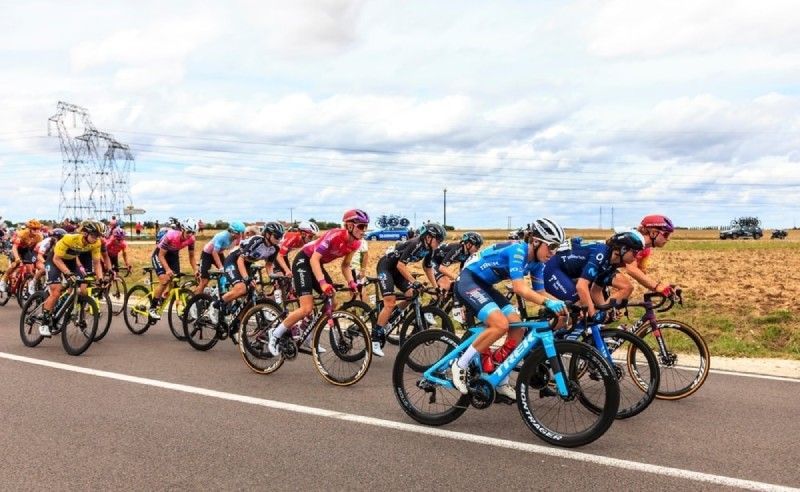
Road cycling races test riders' endurance, speed, and tactical prowess on paved courses. They can be one-day affairs or grueling multi-day stage races that cover hundreds of kilometers.
- Brief History: Road races have a long and storied history, with some events dating back over a century.
- Early Origins (Late 19th Century):
- Emerged in the late 1800s alongside the rising popularity of bicycles.
- Early races were held on public roads, often spanning long distances.
- The first documented race occurred in 1868 in Paris.
- Pioneering Races:
- Liège–Bastogne–Liège (1892), Paris–Roubaix (1896), and the Tour de France (1903) were among the first major races.
- These races established the sport's format: multi-stage, one-day classics, and challenging terrains.
- Growth and Expansion (Early 20th Century):
- Popularity spread across Europe, with major races in Italy (Giro d'Italia, 1909), Belgium (Tour of Flanders, 1913), and Spain (Vuelta a España, 1935).
- Iconic one-day classics like Milan–San Remo (1907) and Giro di Lombardia (1905) were established.
- Globalization and Professionalization (Mid-20th Century):
- Road cycling expanded beyond Europe to North America, South America, and Asia.
- The sport became professionalized, with sponsored teams and salaried riders.
- Key Figures:
- Henri Desgrange (founder of the Tour de France) and Eddy Merckx (five-time Tour de France winner) were early pioneers.
- Examples of Iconic Race Events:
- Tour de France: The pinnacle of stage racing
- Giro d'Italia: Italy's epic answer to the Tour
- Spring Classics: One-day races known for brutal conditions (think cobblestones)
- Individual Races vs. Stage Races:
- Individual Races: Single-day events, the winner takes it all
- Stage Races: Span multiple days with winners decided by cumulative time
- Categories (Pro, 1, 2, 3, 4, 5) Racing categories group riders based on ability, ensuring fair competition. Here's a breakdown of the typical categories:
- Professional (Pro): The top tier of cycling, featuring the world's best riders competing for fame, glory, and lucrative contracts. Pro riders race under the UCI (Union Cycliste Internationale) sanction and compete in prestigious events like the Tour de France and Giro d'Italia.
- Category 1, 2, 3, 4, 5: These categories are for amateur riders, with Cat 1 being the highest level and Cat 5 being the most beginner-friendly. Categories are typically determined by a points system based on race results. Riders earn points based on their finishing position in races within their category. The more points you accumulate, the higher the category you can potentially qualify for. This system allows riders to progress gradually as their skills improve and compete against riders of similar abilities.
- Types of Road Races
- Road race: The classic format, often with rolling terrain and mass group finishes.
- Criterium race: Short circuits with lots of corners – fast, technical, and spectator-friendly.
- Time trial race: The race of truth. Riders fight solo against the clock for the fastest time.
2. Mountain Bike Races
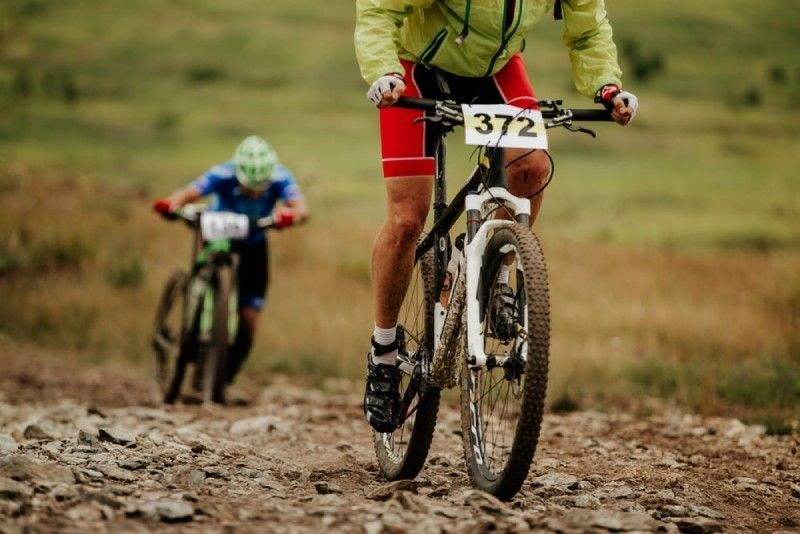
Mountain bike races are adrenaline-pumping competitions that challenge riders to navigate technical terrain, climb steep inclines, and descend at high speeds. These off-road races test riders' technical skills, physical fitness, and mental fortitude as they conquer obstacles like rocks, roots, and jumps.
Disciplines like Cross Country (XC) emphasize endurance and tactical racing on winding single-track courses, while Downhill (DH) focuses on pure speed, with riders racing the clock on challenging downhill slopes.
- Brief History: The early races were wild and unregulated, leading to the formation of governing bodies and standardized formats.
- Early Origins (1970s):
- Emerged in the 1970s in California, USA, where cyclists modified bikes for off-road use.
- Early races were held on fire roads and trails, often with modified beach cruiser bikes.
- "Repack" races in Marin County, California, are considered some of the earliest organized mountain bike events.
- Pioneering Races and Figures:
- The Repack downhill race (1976) and the Crested Butte to Aspen race (1978) were early milestones.
- Pioneers like Gary Fisher, Charlie Kelly, Joe Breeze, and Tom Ritchey played crucial roles in developing mountain bikes and promoting the sport.
- Growth and Diversification (1980s-1990s):
- Mountain biking gained popularity in the 1980s and 1990s, with new disciplines emerging.
- Cross-country (XC), downhill (DH), and dual slalom became established race formats.
- Specialized mountain bike brands and manufacturers emerged, driving innovation.
- Recognition and Expansion (1990s-Present):
- The Union Cycliste Internationale (UCI) recognized mountain biking as an official discipline in 1990.
- The first UCI Mountain Bike World Championships were held in 1990.
- Mountain biking expanded globally, with races and events held worldwide.
- The sport was introduced to the Olympic Games in 1996.
- Examples of Iconic Race Events:
- UCI Mountain Bike World Cup: Series featuring different disciplines
- Cape Epic (South Africa): Grueling multi-day stage race
- Leadville Trail 100 (USA): Legendary high-altitude endurance test.
- Types of Mountain Bike Races:
- Cross Country (XC): The most common format – multiple laps on technical courses
- Cross Country Marathon (XCM): Longer, more endurance-focused races
- Cross Country Short Track (XCC): Short, intense races for explosive riders
- Downhill (DH): All about speed. Individual riders race the clock on gnarly descents.
- Gravity Enduro: Blends downhill speed with technical uphill climbs, a true all-around test.
- Freestyle/Freeride: Think Red Bull Rampage – massive jumps and death-defying tricks scored by judges.
3. Gravel Races
Gravel races offer cyclists the chance to experience the freedom of off-road riding while maintaining the speed and efficiency of road cycling. These races take place on dirt roads, gravel paths, and even some sections of paved roads, providing a scenic and varied riding experience. Gravel bike races range in distance from shorter, faster events focused on pure speed to epic multi-day adventures that challenge riders' overall fitness and endurance.
- Brief History: Gravel racing is booming. It emerged in the early 2000s with events like the iconic Dirty Kanza (now Unbound Gravel) gaining cult status.
- Early Origins (Late 19th/Early 20th Century):
- Gravel racing has roots in the earliest days of road cycling when most roads were unpaved.
- Races like Paris-Roubaix and early Tour de France stages included significant portions of unpaved roads.
- Resurgence and Evolution (2000s):
- The modern gravel racing scene began to emerge in the mid-2000s in the United States.
- Events like the Dirty Kanza (now Unbound Gravel) in Kansas and the Trans-Iowa gained popularity.
- This resurgence was driven by a desire for adventure, a return to the roots of cycling, and the availability of versatile gravel bikes.
- Growth and Diversification (2010s-Present):
- Gravel racing experienced rapid growth in the 2010s, with new events popping up across the globe.
- Race formats diversified, ranging from short and fast events to ultra-endurance challenges.
- The sport attracted a wide range of riders, from road cyclists and mountain bikers to casual enthusiasts.
- Formalization and Recognition (2020s):
- The UCI (Union Cycliste Internationale) introduced the Gravel World Series in 2022, marking the official recognition of gravel racing as a distinct discipline.
- The first UCI Gravel World Championships were held in 2022, further legitimizing the sport.
- Examples of Iconic Race Events:
- Unbound Gravel (USA): The granddaddy of gravel races, known for its 200-mile length
- Belgian Waffle Ride (USA): Uniquely challenging mix of terrain
- Grinduro (USA/Europe): Blends gravel racing with enduro-style timed segments.
- Types of Gravel Races: Gravel events vary wildly in distance and terrain. Some are pure speed fests on smooth dirt, while others are epic endurance tests over mixed surfaces.
4. Ultra-Distance Races / Ultra-Marathon Cycling
The ultimate test of human endurance, ultra-distance races cover massive distances, often exceeding 1,000 kilometers and requiring riders to race non-stop for days at a time.
These epic challenges push cyclists to their physical and mental limits, demanding exceptional fitness, strategic planning, and a strong support crew to help them conquer the course and achieve victory. Iconic races like the Race Across America (RAAM) have become legendary for their grueling terrain and the incredible feats of human accomplishment they inspire.
- Brief History: Ultra-distance cycling pushes the limits of human endurance. Events like the Race Across America have been around for decades, inspiring epic feats of courage.
- Early Origins (Early 20th Century):
- Ultra-distance cycling traces its roots to early endurance challenges on road bicycles.
- Races like Bordeaux-Paris (560km) and long stages of the early Tour de France pushed the limits of human endurance.
- Pioneering Events (Mid-20th Century):
- The first official ultra-distance cycling race, the Paris-Brest-Paris (PBP) randonneuring event, was established in 1891 and continues to this day.
- The Race Across America (RAAM) was founded in 1982 and became the most prestigious ultra-cycling race in the world.
- Rise of Modern Ultra-Cycling (Late 20th Century):
- The late 20th century saw the emergence of various ultra-cycling formats, including 24-hour races, multi-day stage races, and self-supported events.
- The UltraMarathon Cycling Association (UMCA) was founded in 1992 to promote and govern ultra-cycling events.
- Globalization and Diversification (21st Century):
- Ultra-cycling expanded globally, with events held on every continent.
- New formats like bikepacking races and self-supported ultra-endurance events gained popularity.
- The Transcontinental Race, a self-supported race across Europe, became a major event in the ultra-cycling calendar.
- Modern Era (2010s-Present):
- Ultra-cycling continues to grow in popularity, attracting a diverse range of athletes.
- Technological advancements in GPS tracking and navigation have made self-supported ultra-endurance races more accessible and safe.
- The sport is constantly evolving, with new challenges and events pushing the boundaries of human endurance.
- Examples of Iconic Race Events:
- Race Across America (RAAM): The ultimate test, crossing the USA non-stop
- Transcontinental Race (Europe): Self-supported race across the continent
5. BMX Races
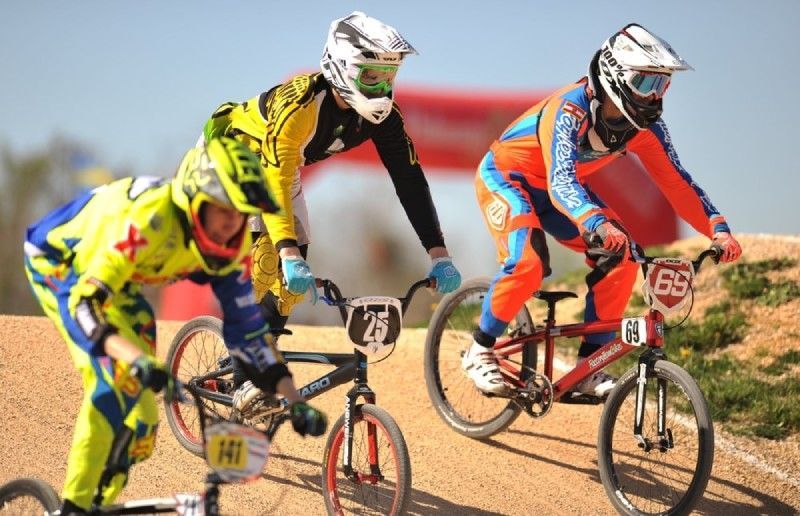
BMX races are short, explosive competitions that take place on purpose-built BMX tracks. These tracks feature jumps, berms (banked turns), and tight corners, demanding a unique combination of bike handling skills, aerial maneuvers, and strategic racing. BMX races can involve mass starts with multiple riders battling it out for position, or time trials where riders race the clock individually to achieve the fastest time.
- Brief History: BMX racing is as old as BMX itself. Early competitions were informal, but the sport quickly became organized with governing bodies and dedicated race tracks.
- Early Origins (1960s-1970s):
- Emerged in the late 1960s and early 1970s in Southern California, USA.
- Inspired by motocross, kids began racing modified bicycles on dirt tracks.
- Early races were informal, held on vacant lots and makeshift tracks.
- Pioneering Races and Figures:
- The first official BMX race was held on July 10, 1969, in Palms Park, Santa Monica, California.
- Early pioneers like Scot Breithaupt (founder of SE Racing) and George Esser (founder of the National Bicycle League) played crucial roles in organizing and promoting the sport.
- Growth and Formalization (1970s):
- BMX's popularity exploded in the 1970s, with tracks and races springing up across the United States.
- The American Bicycle Association (ABA) was founded in 1977, providing a national sanctioning body for races.
- BMX bikes and components became specialized, with dedicated manufacturers and brands emerging.
- Global Expansion and Recognition (1980s-Present):
- BMX spread to other countries, with national and international racing organizations established.
- The International BMX Federation (IBMXF) was founded in 1981, leading to the first BMX World Championships in 1982.
- BMX racing debuted at the 2008 Beijing Olympic Games, further legitimizing the sport.
- Modern BMX Racing:
- BMX racing remains popular worldwide, with events held at all levels, from local to professional.
- The sport continues to evolve, with new tracks, formats, and technological advancements.
- Examples of Iconic Race Events:
- UCI BMX World Championships: The top level of BMX racing
- USA BMX National Series: Series for riders of all levels
6. Cyclocross Races
A wild hybrid of road cycling and running. Cyclocross courses are short and technical, featuring obstacles like mud, sand, barriers, and steep climbs that force riders to dismount and carry their bikes. Known for its chaotic starts, unpredictable racing, and spectator-friendly atmosphere.
- Brief History: Began in Europe as a way for road cyclists to stay fit during winter. It quickly evolved into a thrilling and beloved sport.
- Early Origins (Early 20th Century):
- Emerged in Europe in the early 1900s as a way for road cyclists to stay fit during the winter off-season.
- Riders would race across fields and obstacles, often dismounting and carrying their bikes.
- The first French National Championship was held in 1902.
- Growth and Formalization (Mid-20th Century):
- Cyclocross gained popularity in Belgium and the Netherlands in the 1940s and 1950s.
- The first UCI Cyclocross World Championships were held in 1950.
- The Superprestige series, a series of prestigious cyclocross races in Belgium, was established in 1982.
- Global Expansion and Popularity (Late 20th Century – Present):
- Cyclocross spread to other countries, including the United States, in the late 20th century.
- The sport gained a following for its spectator-friendly format and challenging conditions.
- Cyclocross bikes and technology evolved, with specific tire treads, frame designs, and gearing becoming standard.
- Modern Cyclocross:
- Cyclocross races are held worldwide during the fall and winter months.
- The sport continues to evolve, with new courses, formats, and technologies.
- Cyclocross remains a popular discipline for both professional and amateur cyclists.
- Examples of Iconic Race Events:
- UCI Cyclocross World Cup: The top level of competition
- National Championships: Hosted by individual countries
7. Track Cycling Races
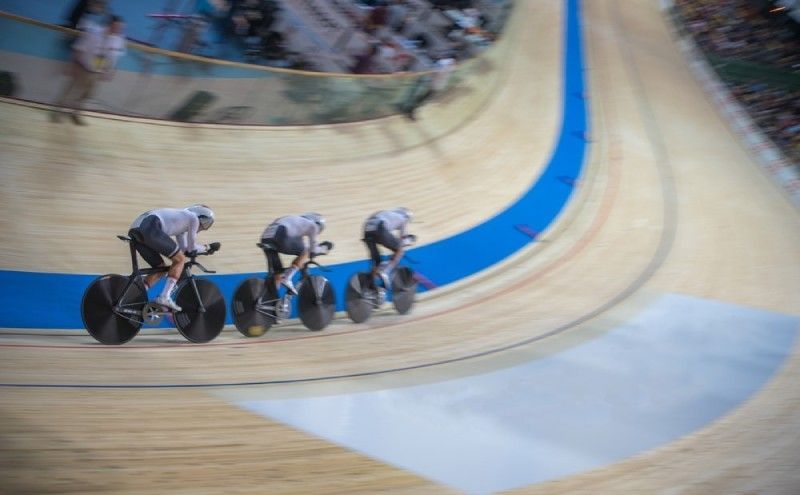
High-speed, high-stakes competition on a banked, oval track (the velodrome). Track cycling encompasses various race formats, demanding power, precision, and tactical acumen.
- Brief History: Dates back to the late 1800s and is one of the oldest Olympic sports.
- Early Origins (Late 19th Century):
- Emerged in the late 1800s with the construction of velodromes (oval tracks) specifically for bicycle racing.
- Early tracks were often made of wood and featured steep banked turns.
- Track cycling quickly became a popular spectator sport, with races held indoors and outdoors.
- Pioneering Races and Figures:
- The first world championships were held in 1893 in Chicago, featuring sprint and motor-paced races.
- Six-day racing, a multi-day endurance event with teams of two riders, became popular in the early 20th century.
- Major Taylor, an African American cyclist, was a dominant figure in sprint racing in the late 1890s and early 1900s.
- Olympic Inclusion and Growth (20th Century):
- Track cycling has been part of the Olympic Games since the first modern Olympics in 1896.
- Women's track cycling events were added to the Olympics in 1988.
- New disciplines like the team pursuit, team sprint, and keirin were introduced in the 20th century.
- Modern Track Cycling:
- Track cycling remains a popular sport worldwide, with events held at all levels, from local to professional.
- The UCI Track Cycling World Championships are the pinnacle of the sport, featuring various disciplines.
- Technological advancements in bike design and track construction have led to faster and more exciting racing.
- Examples of Iconic Race Events:
- UCI Track Cycling World Championships: The pinnacle of track racing
- Six-Day Racing: Old-school, multi-day endurance tests (not Olympic)
- Olympic events vs. non-Olympic races: The Olympics feature a select group of track cycling disciplines, while non-Olympic events showcase a broader range of formats.
8. Sprint (Olympic)
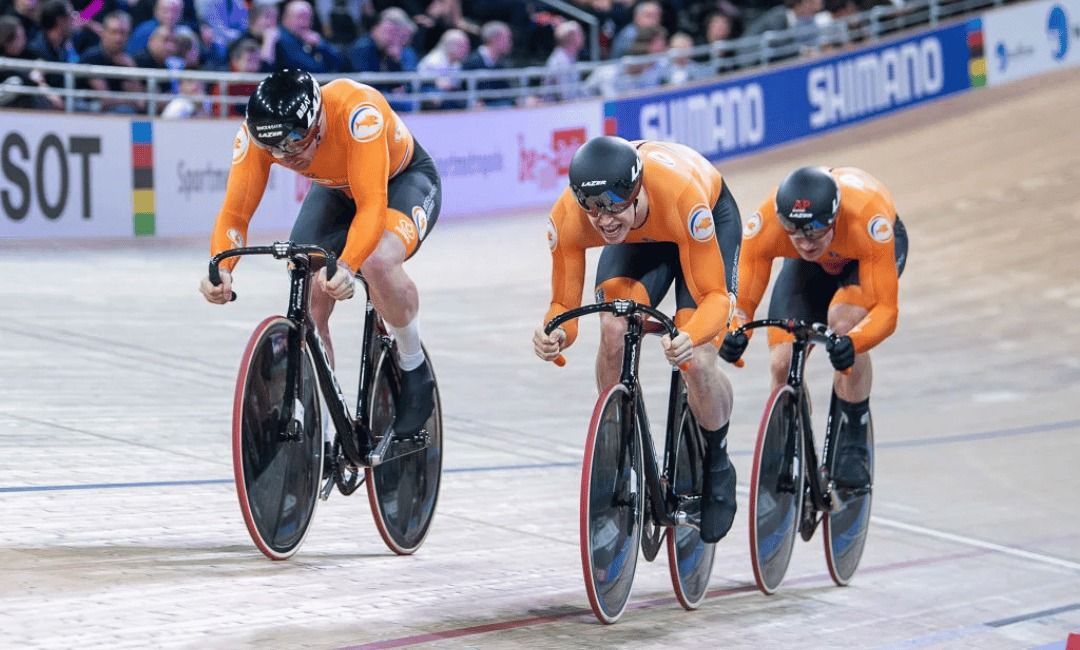
A pure test of raw power and speed. This individual event features riders facing off in heats, with only the top finishers progressing to the next round. The final match is an all-out battle where riders jockey for position, utilizing tactics and bursts of explosive power to cross the finish line first.
- Early Origins (1896):
- The sprint event has been a part of the Olympic Games since the inaugural modern Olympics in Athens in 1896.
- Initially, it was a simple match race between two riders over a distance of approximately 2,000 meters.
- Evolution of Format (Early 20th Century):
- The format evolved over time, with the introduction of qualifying rounds, heats, and repechages.
- The distance was standardized to 1,000 meters for men and 750 meters for women (introduced in 1988).
- Golden Era (Mid-20th Century):
- The mid-20th century saw the emergence of legendary sprinters like Arie van Vliet (Netherlands) and Daniel Morelon (France).
- These riders dominated the Olympic sprint events, setting records and captivating audiences with their speed and tactical prowess.
- Modern Era (Late 20th Century – Present):
- Sprint cycling continued to evolve, with advancements in bike technology and training methods.
- New stars emerged, such as Chris Hoy (Great Britain) and Anna Meares (Australia), who won multiple Olympic gold medals in sprint events.
- The introduction of the keirin, a sprint event with a motorized pacer, added another exciting dimension to Olympic track cycling.
- Current Format:
- The Olympic sprint event involves a series of qualifying rounds, heats, and repechages.
- Riders compete in head-to-head match sprints, with the winner advancing to the next round.
- The final round determines the gold, silver, and bronze medalists.
9. Keirin (Olympic)
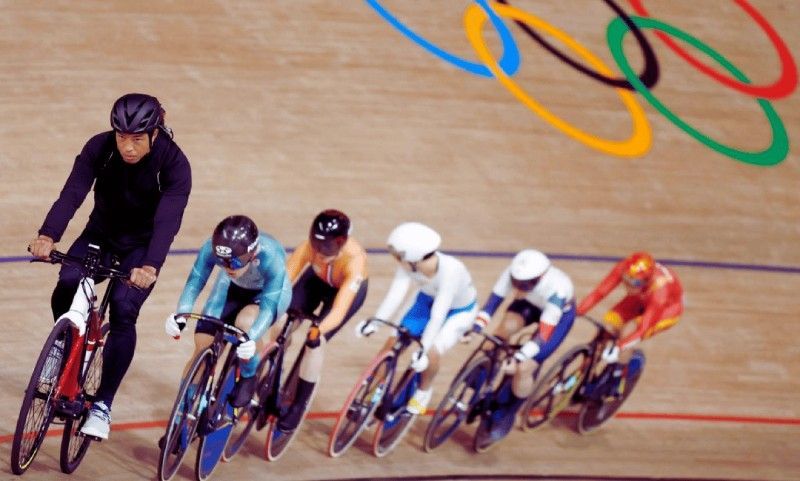
Keirin races are a thrilling mix of strategy and speed. Riders start behind a motorized pacer that gradually increases speed over several laps. This pacer, called a derny, creates a drafting effect, allowing riders to conserve energy before the explosive final sprint. Once the derny peels off with a few laps to go, the remaining riders unleash their power in a high-speed battle for the win.
- Early Origins (1948):
- Keirin originated in Japan around 1948 as a gambling sport at velodromes.
- The format involved cyclists riding behind a pacer (often a motorized bicycle) who gradually increased speed before pulling off the track, leaving the riders to sprint for the finish.
- Global Recognition and Olympic Inclusion (1996-2000):
- Keirin gained international recognition and was added to the UCI Track Cycling World Championships in 1980.
- After years of lobbying, Keirin was finally introduced to the Olympic Games at the 2000 Sydney Olympics as a men's event.
- The women's keirin event was added at the 2012 London Olympics.
- Olympic Format:
- In the Olympic keirin, 6-7 riders start behind a derny (motorized pacer).
- The derny gradually increases speed over several laps before pulling off the track with about 2.5 laps remaining.
- The riders then sprint for the finish line.
- Notable Olympic Moments and Champions:
- Florian Rousseau (France) won the first Olympic gold medal in keirin in 2000.
- Chris Hoy (Great Britain) won gold in both the 2008 Beijing Olympics and the 2012 London Olympics.
- Jason Kenny (Great Britain) won gold in the 2016 Rio Olympics and the 2020 Tokyo Olympics, becoming the most successful Olympic keirin racer.
- Controversies:
- There were allegations of bribery surrounding the inclusion of keirin in the Olympics, but no conclusive evidence was found.
10. Madison (Olympic)
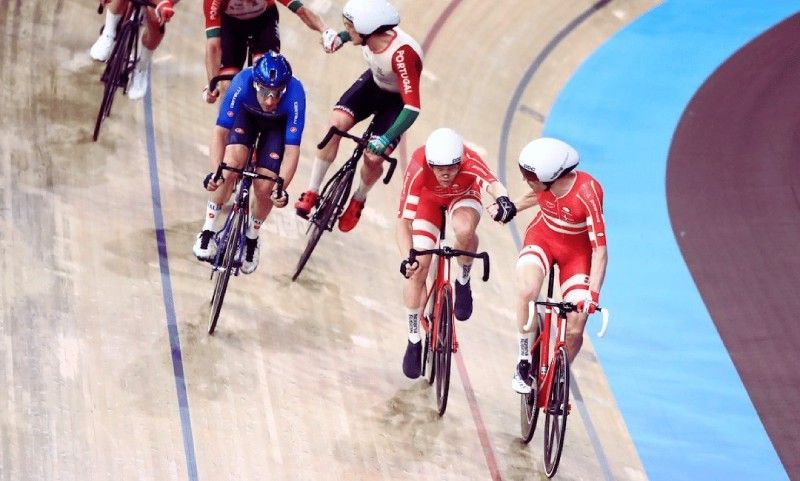
Think of it as a fast-paced tag team race on the track. Teams of two riders work together to achieve victory. One rider will sprint for a lap, then strategically slow down and allow their teammate to slingshot past them with a hand-sling maneuver. This continuous exchange creates a captivating dance of speed and teamwork, demanding exceptional coordination and race strategy from both riders.
- Early Origins (Late 19th Century):
- The Madison originated in the late 1890s as a way to circumvent rules in six-day races that limited individual rider fatigue.
- Named after Madison Square Garden in New York, where these races were popular.
- Two-rider teams would tag in and out, allowing for continuous racing and increased excitement.
- Olympic Inclusion and Removal (2000-2008):
- The Madison was introduced as a men's event at the 2000 Sydney Olympics.
- It was contested again in 2004 and 2008 but removed from the 2012 London Olympics due to gender equality concerns, as there was no equivalent women's event at the time.
- Reintroduction and Expansion (2020):
- The Madison returned to the Olympics in 2020 (held in 2021 due to the COVID-19 pandemic) with both men's and women's events.
- This marked a significant step towards gender parity in track cycling.
- Olympic Format:
- Teams of two riders compete in a points race over a set distance (50km for men, 30km for women).
- Points are awarded for sprints every 10 laps and for lapping the field.
- The team with the most points at the end of the race wins.
11. Team Sprint (Olympic)
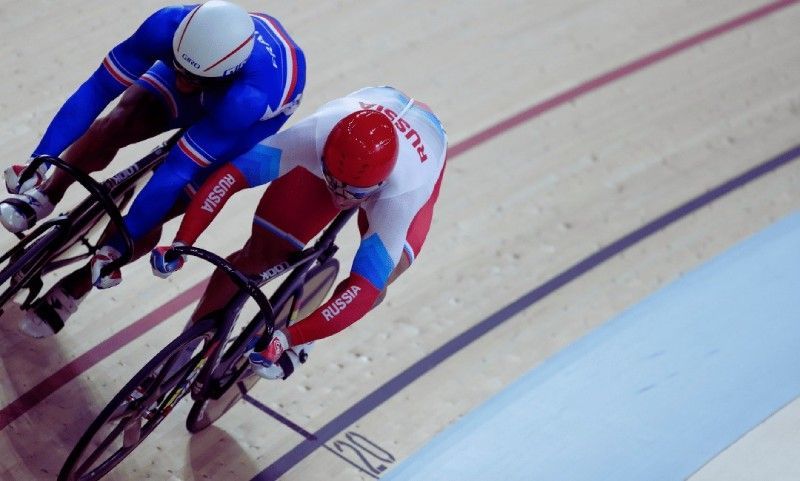
A test of teamwork and explosive power. Teams of three riders (men) or two (women) work together in a perfectly choreographed ballet of speed. Riders take turns leading the charge on a time-trial format, each completing a designated number of laps before peeling off to minimize wind resistance for their teammates.
The team's cumulative time determines the winner. This strategy demands exceptional teamwork, power, and bike handling skills, as riders must slingshot their teammates into the lead while maintaining high speeds and precise positioning on the track.
- Origins (1990s):
- The team sprint emerged in the 1990s as a new and dynamic track cycling discipline.
- It involves teams of three riders (two for women) racing over three laps (two for women), with each rider taking a turn leading.
- Olympic Inclusion (2000):
- The team sprint was introduced to the Olympic Games at the 2000 Sydney Olympics for men.
- The women's team sprint debuted at the 2012 London Olympics.
- Olympic Format:
- Teams race head-to-head, with the fastest team advancing through the rounds.
- Each rider leads for one lap before peeling off, leaving the next rider to take over.
- The final time is taken when the last rider crosses the finish line.
12. Team Pursuit (Olympic)
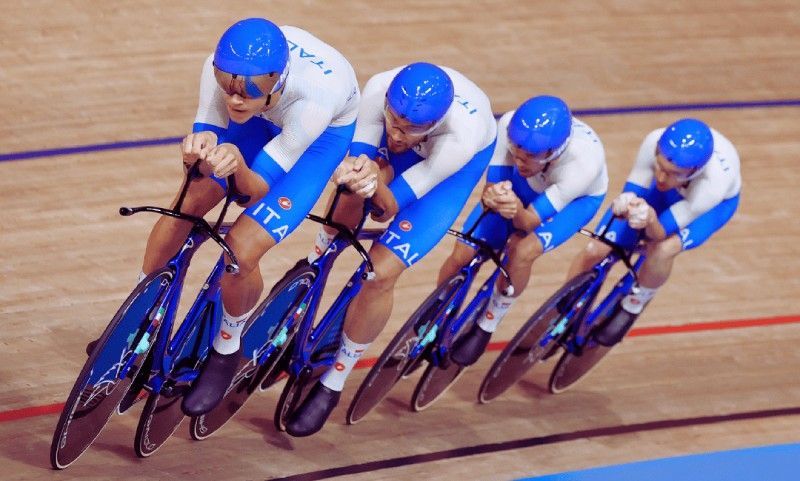
It's like a chase on wheels, but with a strategic twist. Teams of four riders battle it out over a distance of 4 kilometers (men) or 3 kilometers (women). Unlike the Team Sprint, riders don't take turns leading.
Instead, they utilize precise formations for drafting, taking turns at the front to minimize wind resistance for their teammates while maintaining top speed throughout the race. The clock stops when the third rider of a team crosses the finish line, adding an element of strategy as teams decide the optimal moment for the final rider to pull ahead and secure victory.
- Origins (Early 20th Century):
- The team pursuit has its roots in early 20th century track cycling, with four-rider teams competing over a distance of 4,000 meters.
- Olympic Inclusion and Evolution:
- The team pursuit was first included in the Olympics in 1908 for men.
- Women's team pursuit was added in 2012 with four-rider teams racing over 4,000 meters.
- The format changed in 2014 to four-rider teams racing over 4,000 meters for both men and women.
- Olympic Format:
- Two teams start on opposite sides of the track and race to catch the other team or record the fastest time over 4,000 meters.
- Riders take turns leading, rotating to the back of the paceline to conserve energy.
13. Omnium (Olympic)
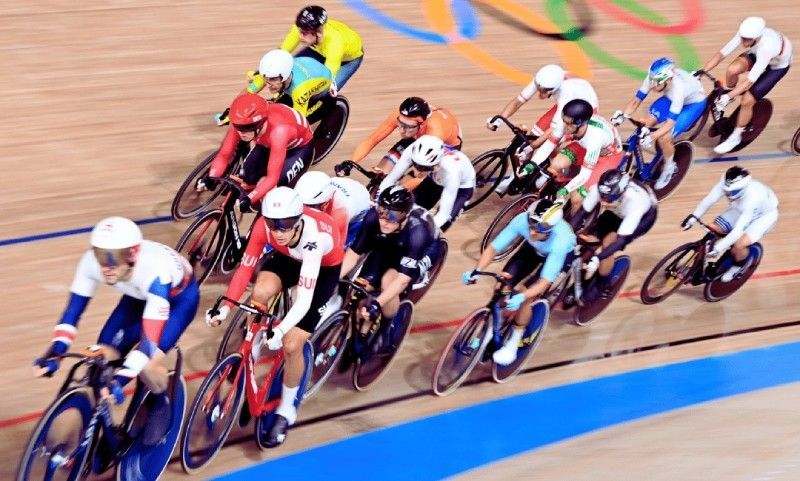
The ultimate test of a track cyclist's all-around abilities, the omnium is a grueling and exciting competition spread over a single day. Riders compete in a series of diverse events that challenge different aspects of their cycling prowess:
- Scratch Race: A pure test of speed and positioning in a mass-start race where the first rider to cross the finish line wins.
- Tempo Race: Riders score points every lap for gaining a lead over the pack. This format demands a combination of speed, endurance, and tactical awareness.
- Elimination Race: A fast-paced and unpredictable event where the last rider across the line every two laps is eliminated. The remaining rider takes home the win, making for a constantly shifting battle for survival.
Early Origins (2007):
- Introduced by the UCI in 2007 to replace the individual pursuit, points race, and madison in world championships.
- Designed to test riders' overall track cycling abilities across multiple disciplines.
- Olympic Inclusion (2012):
- Added to the Olympic program for both men and women at the 2012 London Olympics.
- Initial format consisted of six events over two days.
- Evolution and Current Format:
- The format has evolved over time, with the number of events and scoring system changing.
- As of the 2020 Tokyo Olympics, the omnium consists of four events held in a single day:
- Scratch Race: A mass-start race where the first rider to cross the finish line wins.
- Tempo Race: A points race with intermediate sprints every lap.
- Elimination Race: Riders are eliminated at set intervals until only one remains.
- Points Race: A longer points race with sprints every 10 laps and points for lapping the field.
14. Individual Pursuit
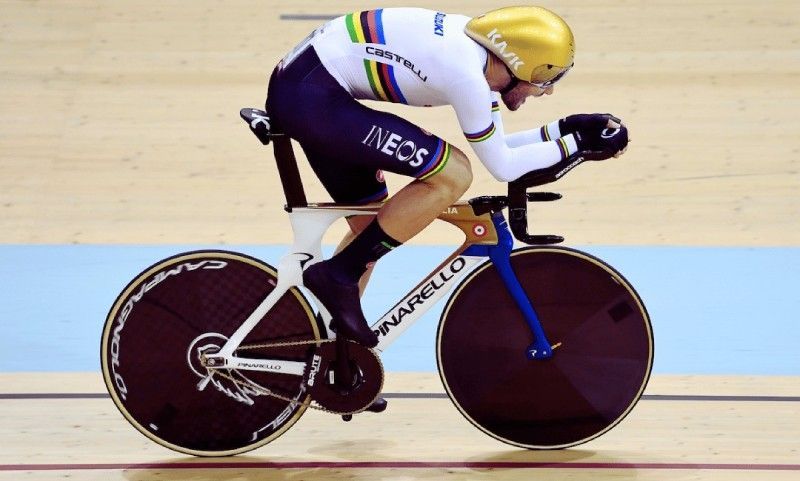
A race against the clock for pure power and precision. Two riders start on opposite sides of the track, each aiming to set the fastest time over a set distance (4km for men, 3 km for women) or catch their opponent. Riders rely on a combination of raw power, pacing strategies, and perfect technique to overcome wind resistance and achieve the fastest time possible.
- Early Origins (19th Century):
- One of the oldest track cycling disciplines, dating back to the early days of velodrome racing.
- Two riders start on opposite sides of the track and race to catch their opponent or record the fastest time over a set distance.
- Olympic Inclusion and Evolution:
- Included in the Olympic Games for men since 1964 and for women since 1988.
- Originally raced over 4,000 meters for men and 3,000 meters for women.
- Distance changed to 4,000 meters for both men and women in 2012.
- Removed from the Olympic program after the 2020 Tokyo Olympics due to schedule constraints.
15. Points Race
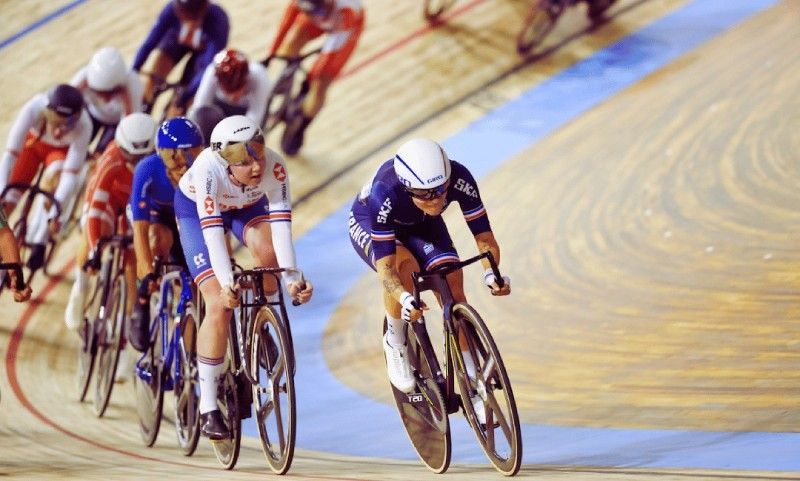
A long-distance event where sprints peppered throughout the race determine the winner. Riders score points in these intermediate sprints and by lapping the field. This format demands both endurance to survive the long distances and explosive power to succeed in the sprints.
Also, strong tactical awareness is crucial, as riders jockey for position, form alliances, and launch attacks at opportune moments to maximize their point collection and outsmart their opponents.
- Early Origins (Late 19th Century):
- The points race emerged in the late 1800s as a dynamic alternative to traditional endurance races.
- Points are awarded for winning intermediate sprints and for lapping the field.
- Olympic Inclusion and Evolution:
- Included in the Olympic Games for men since 1900 and for women since 1996.
- Distance has varied over the years, but is currently 40km for men and 25km for women.
- Scoring system has also been adjusted over time, with varying points awarded for sprints and laps.
16. Scratch Race

A crowd-pleasing spectacle that comes down to a final, all-out sprint. Riders start together in a mass-start format, and the first rider to cross the finish line wins. This simple premise often leads to chaotic and unpredictable racing, with surprise attacks, last-lap surges, and photo finishes keeping spectators on the edge of their seats.
- Early Origins (Early 20th Century):
- The scratch race has roots in the earliest days of track cycling, where simple mass-start races were common.
- It evolved into a standardized discipline with a set distance and simple rules: first rider across the finish line wins.
- Olympic Inclusion and Exclusion:
- While not part of the initial Olympic program, the scratch race was included in the World Championships for both men and women from 2002 onwards.
- It was never included in the Olympic Games until it became part of the Omnium event in 2012, which tests riders across multiple track disciplines.
17. Kilo Time Trial (Men) / 500-meter Time Trial (Women)
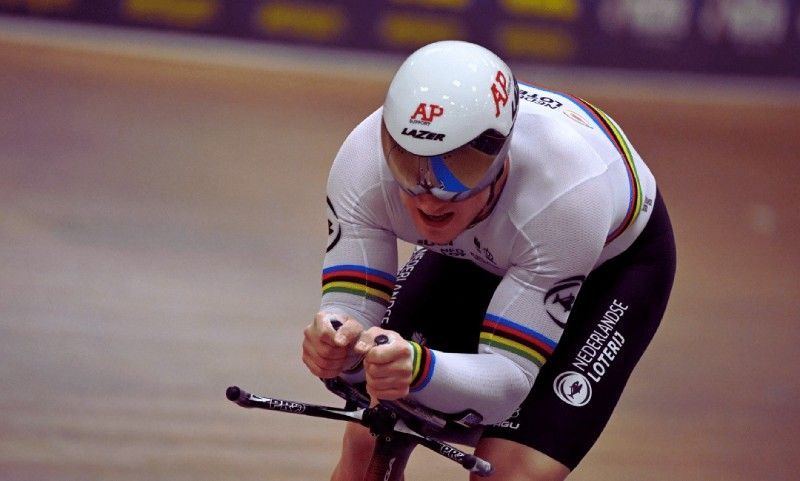
Pure power and perfect pacing are the hallmarks of success in the Kilo Time Trial (men) and 500-meter Time Trial (women). Riders race solo against the clock, aiming to achieve the fastest time possible over their designated distance.
This event requires exceptional leg power to generate maximum speed from the start, coupled with the ability to pace themselves perfectly throughout the short, yet grueling effort. Every fraction of a second counts, making precise pacing and the mental fortitude to sustain a maximal effort crucial for achieving victory.
- Early Origins (19th Century):
- Time trials have been a part of cycling since its earliest days, with riders competing against the clock over set distances.
- The kilo (1,000 meters) became a standard distance for track time trials in the early 20th century.
- Olympic Inclusion and Evolution:
- The men's kilo time trial was first included in the Olympics in 1928 and remained on the program until 2004.
- The women's 500-meter time trial was introduced at the 1988 Olympics and remained until 2004.
- Both events were removed from the Olympic program in 2008 to make way for other disciplines like the BMX.
- Format:
- Riders start individually and race against the clock over the set distance (1,000 meters for men, 500 meters for women).
- The fastest time wins.
- Requires immense power and speed, with riders reaching speeds over 70 km/h.
Bicycle Race Disciplines in the Olympics

The Olympic Games are the pinnacle of athletic competition, showcasing the world's best athletes battling it out for gold medals across a diverse range of sports. Cycling has been a core part of the Olympics since the very first modern Games in 1896, and it continues to enthrall spectators with its blend of endurance, speed, power, and technical skill.
Four distinct cycling disciplines are contested at the Olympics: road cycling, track cycling, mountain biking, and BMX racing. Each discipline offers unique challenges and showcases different aspects of a cyclist's abilities. From the grueling endurance tests of road racing to the fast-paced, adrenaline-fueled world of BMX, Olympic cycling has something to offer every cycling enthusiast.
1. Road Cycling
- Olympic History: One of the original Olympic sports, with road cycling events featured in the very first modern Games in 1896.
- Events:
- Individual Road Race: A long-distance, mass-start race where the first rider to cross the finish line wins. Olympic road races are typically around 200km for men and 140km for women.
- Individual Time Trial: Riders race individually against the clock over a shorter distance (usually 30-50km).
- Key Aspects:
- Endurance and speed: Olympic road races demand exceptional stamina, while bursts of speed and strategic attacks are key to breaking free from the pack.
- Terrain: Olympic road courses can be hilly and challenging, providing opportunities for climbing specialists and tactically savvy riders to shine.
- Teamwork: While riders compete individually, strong national teams often work together to control the pace and set up their strongest riders for victory.
2. Track Cycling
- Olympic History: Track cycling has been in the Olympics since 1896 and offers a wide range of thrilling events.
- Events:
- Sprint (individual and team): Short, explosive contests of pure power and tactics.
- Keirin: Strategic racing with a motorized pacer adding to the drama.
- Madison: Tag-team racing requiring speed and exceptional teamwork.
- Omnium: A multi-event test of all-around track cycling skills.
- Team Pursuit & Individual Pursuit: Riders race against the clock for the fastest time.
- Key Aspects
- Velodromes: Races take place on banked, oval tracks made of wood or concrete.
- Specialized Bikes: Track bikes have a fixed gear, no brakes, and geometries optimized for specific events.
- Power, technique, and tactics: Different events demand different strengths, creating a variety of exciting competitions.
3. Mountain Biking
- Olympic History: The youngest of the Olympic cycling disciplines, introduced in 1996.
- Events:
- Cross-country (XCO): The only Olympic mountain biking event, featuring multiple laps on technical courses with climbs and descents.
- Key Aspects:
- Challenging terrain: Olympic XCO courses are designed to push riders to the limit, with technical features, and demanding climbs.
- Bike handling skills: Riders need to be masters of their bikes to negotiate difficult sections and descend with speed and control.
- Endurance and tactical racing: Riders must combine stamina with a smart race strategy to conquer the grueling courses.
4. BMX Racing
- Olympic History: BMX became an Olympic sport in 2008.
- Events:
- BMX Racing: Individual riders race on a purpose-built track with jumps and berms.
- Key Aspects:
- Explosive power: Riders need burst power for the start and to clear jumps.
- Bike handling: Precision and split-second decisions are needed to tackle jumps and corners confidently.
- Race dynamics: BMX races are fast, dynamic, and full of contact between riders.
Olympic cycling showcases the absolute pinnacle of athleticism and cycling skill. Whether it's the epic endurance battles of the road race, the explosive power of track events, the technical mastery of mountain biking, or the thrilling spectacle of BMX racing, the Olympics have something to captivate every cycling fan.
These events bring together the world's best riders, pushing the limits of human performance and inspiring viewers with their incredible feats of strength, speed, and courage.
Ride Protected, Ride Safe, with Bike Legal
At Bike Legal, we are cyclists representing cyclists. Whether you ride road, gravel, or mountain, if you've been involved in a bicycle accident, our experienced team is here to help.
With over 500 cases handled nationwide, we bring unmatched legal expertise and a deep understanding of bicycle laws to secure the compensation you deserve. Ride with confidence, knowing you have passionate advocates on your side. Contact Bike Legal today for a free consultation.
Check out our blog for the latest in cycling topics, laws, and news:
- What To Do After a Bicycle Crash: A Cyclist's Checklist
- Common Dangers of Cycling on the Road
- Answers to the Most Common Questions About Bicycle Accidents
- Do Cyclists Have to Stop at Stop Signs? (Updated for 2024)
- Cycling Laws in the United States
- The Tour de France: Cycling's Ultimate Race
- Top 15 Famous Cyclists That Every Road Cyclist should Know
- How Much Do Pro Cyclists Make?
- Twenty Types of Bicycle Accidents and Prevention Tips
- Legal Tips for Bicycle Injury Lawsuits

FAQs
How many disciplines are there in cycling?
Cycling is incredibly diverse, with a vast number of disciplines. While professional organizations recognize a core set of major disciplines, numerous subsets and niche styles exist. Here's a quick overview:
- Major Disciplines:
- Road Cycling
- Mountain Biking
- Cyclocross
- Track Cycling
- BMX
- Gravel Biking
- Subsets and Less-Common Disciplines
- Bikepacking/Touring
- Downhill mountain biking
- Trials cycling
- Artistic cycling
- Bike Polo
- ...and many more.
What is a cycling discipline?
A cycling discipline is a specific type of cycling with its own unique rules, equipment, terrain, and skills required. Think of cycling disciplines like different sports within the broader world of cycling.
What are cycling races called?
Cycling races have different names depending on the discipline and format. Some common terms include:
- Road Race: A classic mass-start race on paved roads.
- Criterium: Short, fast races with lots of corners, usually held on city circuits.
- Time Trial: Individual riders race against the clock.
- Stage Race: Multi-day races with varied terrain and challenges (e.g., Tour de France).
- Cyclocross Race: Short course races with obstacles that require dismounting your bike.
- Mountain Bike Race: Various formats (like cross-country, downhill) on off-road trails.
How many types of cycling are in the Olympics?
There are currently four different cycling disciplines contested at the Olympic Games:
- Road Cycling
- Track Cycling
- Mountain Biking
- BMX Racing

